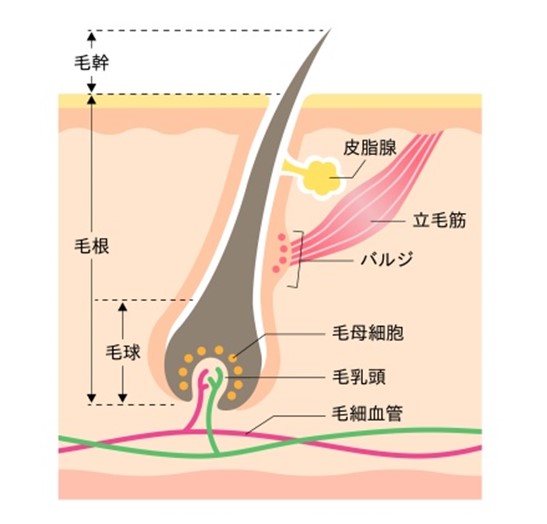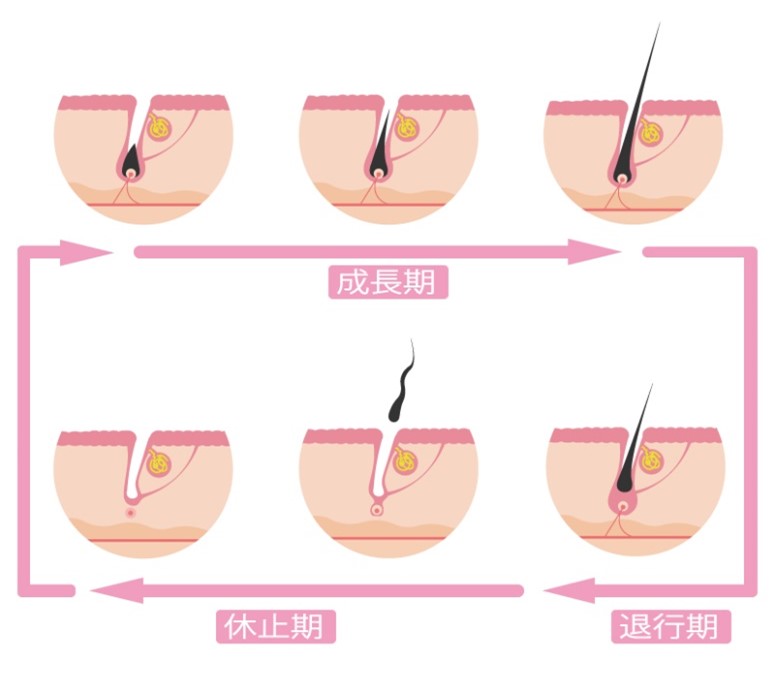A doctor explains the mechanism and effects of medical hair removal in an easy-to-understand manner.

- I'm interested in medical hair removal, but I can't take the first step because I have so many things to think about.
- I would like to have medical hair removal, but there are too many clinics and too much information to choose from."
- I've started medical hair removal, but I still don't feel it's working, and I'm getting worried."
Hello, I am a doctor at Smart Skin Clinic.
Do you all feel this way?
Conclusions,
Theoretically, hairs removed by medical hair removal will not grow back.
Average of 5-8 times for smoothness and 1-2 years for duration
It is said.
However, that is "if the hair removal equipment suitable for the hair type is used.
Understanding how hair and hair removal devices work is very important in hair removal.
To avoid regrets such as "This is not what I was told" or "This is not what I expected" after the treatment, it is important to understand the mechanism of medical hair removal properly.
Chairman of Smart Skin Clinic Group
stone Kouta
career
Graduated from Juntendo University School of Medicine
Tokyo Women's Medical University Hospital and related facilities
Worked at a major beauty clinic in Tokyo
Affiliation / Qualifications
Japan Surgical Society Specialist
Japanese Society of Anti-Aging Medicine
Hair Structure and Mechanism
Before we discuss how to stop hair growth, let us first familiarize ourselves with our enemy, "hair.
The number of hair follicles in our body is said to be about 5 million throughout the body, and their number is determined almost immediately after birth and does not increase during our lifetime.
The part of the hair buried under the skin is called the hair root, and hair is produced by the cells (papilla cells and hair matrix cells) at the root of the hair root.
In recent years, it has also been discovered that there is an important part of the hair shaft, the bulge region, which is responsible for hair growth and regeneration. (See illustration below)

Hair grows and sheds through the hair cycle of "growth phase - regression phase - resting phase".

The hairs we normally see are in the growing and regressing phases, which is said to be about 20-30% of all hairs.
This hair cycle is very important for medical hair removal.
This is because hairs must be in contact with the root cells or bulge region of the hair follicle in order to be epilated.
The reasons are discussed below, but this hair cycle is related to the frequency and duration of clinic visits.
Explanation of medical terms in the article
*Papilla cells = send nutrients and hair growth commands to hair matrix cells
*Hair matrix cells = cells rapidly divide to form hairs when they receive signals for hair growth.
*Bulge area = The hair stem cells, which are the basis of hair cells, are numerous. These stem cells produce hair papilla cells and hair matrix cells and control the hair cycle. The bulge region is said to become inactive at a temperature of about 60°C and cease to function.
How Medical Lasers Work
There are two types of lasers used for medical hair removal: "thermal destructive" and "thermal storage" lasers.
In common with both, the emitted laser light reacts with melanin pigment and is absorbed by the hair. The absorbed light becomes thermal energy and destroys the hair follicles.
The difference between the two is the different targets to be destroyed.
The "thermal destruction type" is the cells at the root of the hair follicle
Thermal storage type" is bulge area
The target is to
| Types of Lasers | Thermal Destruction Type | thermal storage type |
|---|---|---|
| target | Tissue at the root of the hair (Hair matrix cells and papilla) | bulge area |
| feature | Reacts with melanin pigment High-power energy irradiation | Heat is accumulated by repeated irradiation of weak output energy |
| Advantages | Effective for thick and dense hair Short period of time to remove hair after irradiation | Effective on baby hair Low skin burden and can be used even on sensitive skin. Less pain |
| Demerit | Response to hair growth can be weak. Cannot irradiate tanned skin, dark skin, or areas with moles. More painful than the heat storage type | Long period of time after irradiation until the hairs fall out, so it is difficult to feel the effect of hair removal. |
How the Thermal Destruction Type Works
Thermally destructive lasers react only to black melanin pigments.
It works effectively on thick and dense hairs by irradiating them with high pigment absorption and high output energy.
Since the cells that produce hair are directly destroyed, the advantage is that the period between the irradiation and the removal of hair is short.
The disadvantage, however, is that dark skin, tanned skin, pigmented skin, and areas with moles cannot be irradiated because of the risk of burns due to the laser's reaction to that skin.
In addition, it is less likely to react to hair with low melanin pigmentation, such as gray hair and baby hair.
The degree of pain is often likened to that of being "popped by a rubber.
How the heat storage system works
Although heat storage lasers also react to black melanin pigment, the difference is that melanin absorbs the laser at a lower rate than the thermal destruction type.
The heat storage type works by repeatedly irradiating weak output energy to increase the temperature within the hair follicles.
The target bulge area is located in the shallow part of the hair root and is said to be inactivated at about 60°C. Therefore, high power energy is not necessary.
Since the absorption rate of melanin is low, there is little burden on the skin, and irradiation is possible regardless of skin color. It is also effective for hair growth.
The degree of pain is not so great that it is felt as if the irradiated area is warm and tender.
The advantage is that a wide area can be irradiated at one time and the treatment time is short.
On the other hand, the disadvantage is that it does not directly destroy hair root cells, so it takes longer for the hair to fall out than the thermal destruction type.
In addition to the type of laser, medical lasers are also classified according to the length of the laser wavelength.
It is good to know that different types of lasers and wavelengths are effective or ineffective for different hair types and skin types.
Difference in wavelength
In addition to the type of laser, medical hair removal lasers are classified by wavelength length.
Wavelength is
Alexandrite laser
Diode laser
YAG laser
There are three types of
We have organized them in a chart below for your review.

Each can be briefly summarized again as follows.
alexandrite laser
Thermally destructive, reacts to melanin, effective for thicker, thicker hair
Cannot be used depending on skin color.
diode laser
・There are both heat-destructive and heat-storing lasers with a mechanism that acts on melanin.
It is in the middle position among the three and can be used by a wide range of people.
Hair removal efficiency is inferior to alexandrite laser and inferior to YAG laser for deep-rooted hair and skin with high melanin content.
YAG laser
Low melanin absorption rate, delivering wavelengths firmly to hair follicles and destroying hair root cells
Especially effective for deep-rooted hair (beard, armpit, VIO, etc.), light on the skin as it is not affected by melanin pigmentation, and effective even for baby hair.
Because the melanin absorption rate is low, more energy output is required to compensate for the low melanin absorption rate, resulting in a narrower irradiated area and more pain.
How many times will it be smooth?
As explained in the previous section on the structure and mechanism of unwanted hair, hairs have a hair cycle of phases, "growth phase - regression phase - resting phase," and each hair is in a different phase.
If the hairs are not in contact with the root cells or bulge region of the hair follicle, the hair removal laser will not be effective.
Therefore, the most important factor in hair removal is whether or not the hairs are in the growth phase.
Depending on the area, most hairs finish their growth phase in one to three months, so it is said that hair removal is more efficient if you have a treatment every two to three months.
Depending on the amount of hair, it can be expected that the hair will be smooth after 5 to 8 treatments if the right hair removal equipment is used for the area and type of hair to be removed.
Duration of effect of medical hair removal
Once the cells at the root of the hair follicle and the bulge region are destroyed or inactivated, the unwanted hair will not grow back.
In this sense, the hair removal effect lasts a lifetime.
However, for example, if you want to remove hair from your beard and you use a storage diode laser, the hair removal effect may be a little weak.
In addition, if the timing of the treatment was during the regression phase, the hairs will not benefit from the laser and will grow back after the treatment.
In this sense, regular treatment with appropriate hair removal equipment is a surefire way to get the best results.
summary
Finally, a brief summary,
The papilla cells, hair matrix cells, and bulge area at the root of the hair follicle are involved in hair growth and development.
There are two types of medical hair removal lasers: "thermal destructive" and "thermal storage" lasers, which can be further classified into "alexandrite lasers," "diode lasers," and "YAG lasers" according to the length of the wavelength of the laser.
Alexandrite laser is effective for thicker, darker hair, but cannot be used on pigmented skin.
Diode lasers can be used for a wide range of hair types and skin types.
YAG laser is effective for deep-rooted hair to hair growth, and is less stressful to the skin, but it is very painful.
If you have a treatment every 2-3 months, you can have a smooth skin in 5-8 sessions.
With the right hair removal equipment and regular treatment, the hair removal effect lasts a lifetime.
In this article, we explained the mechanism and effects of medical hair removal.
Since each hair removal device has its own advantages and disadvantages, it is important to select the most appropriate method depending on individual circumstances (hair type, skin type, etc.).
Smart Skin Clinic offers "thermal destructive" medical hair removal. If you are interested in this service, please feel free to contact us.




